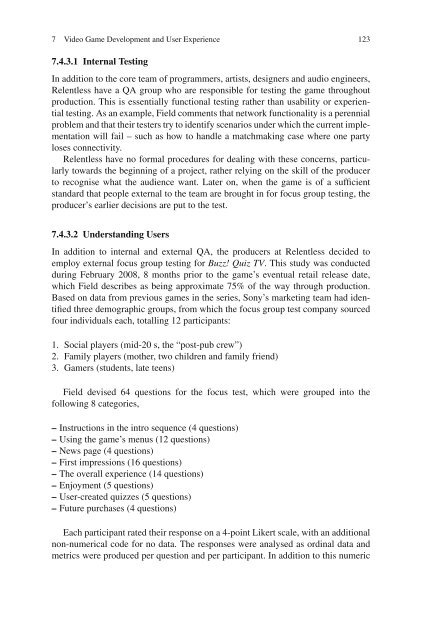Evaluating User Experience in Games: Concepts and Methods - Lirmm
Evaluating User Experience in Games: Concepts and Methods - Lirmm
Evaluating User Experience in Games: Concepts and Methods - Lirmm
Create successful ePaper yourself
Turn your PDF publications into a flip-book with our unique Google optimized e-Paper software.
7 Video Game Development <strong>and</strong> <strong>User</strong> <strong>Experience</strong> 123<br />
7.4.3.1 Internal Test<strong>in</strong>g<br />
In addition to the core team of programmers, artists, designers <strong>and</strong> audio eng<strong>in</strong>eers,<br />
Relentless have a QA group who are responsible for test<strong>in</strong>g the game throughout<br />
production. This is essentially functional test<strong>in</strong>g rather than usability or experiential<br />
test<strong>in</strong>g. As an example, Field comments that network functionality is a perennial<br />
problem <strong>and</strong> that their testers try to identify scenarios under which the current implementation<br />
will fail – such as how to h<strong>and</strong>le a matchmak<strong>in</strong>g case where one party<br />
loses connectivity.<br />
Relentless have no formal procedures for deal<strong>in</strong>g with these concerns, particularly<br />
towards the beg<strong>in</strong>n<strong>in</strong>g of a project, rather rely<strong>in</strong>g on the skill of the producer<br />
to recognise what the audience want. Later on, when the game is of a sufficient<br />
st<strong>and</strong>ard that people external to the team are brought <strong>in</strong> for focus group test<strong>in</strong>g, the<br />
producer’s earlier decisions are put to the test.<br />
7.4.3.2 Underst<strong>and</strong><strong>in</strong>g <strong>User</strong>s<br />
In addition to <strong>in</strong>ternal <strong>and</strong> external QA, the producers at Relentless decided to<br />
employ external focus group test<strong>in</strong>g for Buzz! Quiz TV. This study was conducted<br />
dur<strong>in</strong>g February 2008, 8 months prior to the game’s eventual retail release date,<br />
which Field describes as be<strong>in</strong>g approximate 75% of the way through production.<br />
Based on data from previous games <strong>in</strong> the series, Sony’s market<strong>in</strong>g team had identified<br />
three demographic groups, from which the focus group test company sourced<br />
four <strong>in</strong>dividuals each, totall<strong>in</strong>g 12 participants:<br />
1. Social players (mid-20 s, the “post-pub crew”)<br />
2. Family players (mother, two children <strong>and</strong> family friend)<br />
3. Gamers (students, late teens)<br />
Field devised 64 questions for the focus test, which were grouped <strong>in</strong>to the<br />
follow<strong>in</strong>g 8 categories,<br />
– Instructions <strong>in</strong> the <strong>in</strong>tro sequence (4 questions)<br />
– Us<strong>in</strong>g the game’s menus (12 questions)<br />
– News page (4 questions)<br />
– First impressions (16 questions)<br />
– The overall experience (14 questions)<br />
– Enjoyment (5 questions)<br />
– <strong>User</strong>-created quizzes (5 questions)<br />
– Future purchases (4 questions)<br />
Each participant rated their response on a 4-po<strong>in</strong>t Likert scale, with an additional<br />
non-numerical code for no data. The responses were analysed as ord<strong>in</strong>al data <strong>and</strong><br />
metrics were produced per question <strong>and</strong> per participant. In addition to this numeric

















